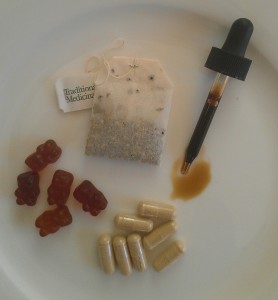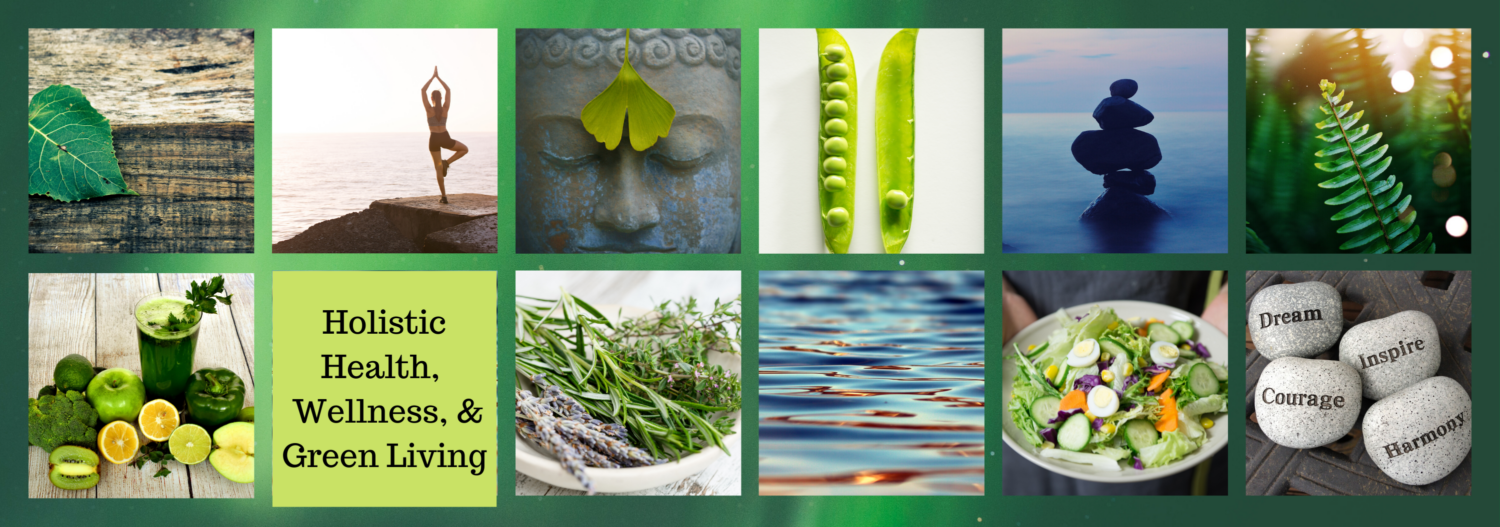
A dizzying array of echinacea supplements exist. Shown here: echinacea tea, glycerin tincture, powder capsules, and gummies.
Given that we’re in the midst of cold and flu season, perhaps you’ve considered taking echinacea? As I discussed in a previous post, echinacea seems to help alleviate cold and flu symptoms and may play a part in boosting immunity, so it’s tempting to give it a try. But which form and kinds of echinacea are best? Read on to discover what to look for when buying an echinacea supplement this season — and stay healthy!
Which form is best?
Enter any natural grocery store or pharmacy and you’re sure to be blown away by all the forms of echinacea supplements available. You’ll find tinctures (in both alcohol and glycerin bases), capsules (powder and liquid), tablets, gummy bears, chewables, and teas. But which one is best?
Out of all of them, my first choice is a tincture, which is also called a liquid extract. What’s a tincture you may be wondering? It’s a way of extracting the herbal constituents of the plant by soaking it in a liquid base of alcohol over a period of time. The plant material is then strained off leaving the liquid behind. Sometimes the alcohol is then evaporated and food-grade glycerin is added in for products made for kids and those sensitive to alcohol. Finally, the tincture is packaged in dark glass bottles to keep the formula from degrading due to light exposure.
Tinctures are not only great because they work really well at extracting the plant’s phytochemicals at the peak of its freshness, but they’re also readily absorbed by the body — making them very effective. So, they’re especially good for those with digestive issues. They are also easy for anyone to take, since a few drops may be added to a glass of water, juice, or hidden in something like applesauce. Note: No pill swallowing required!
When tinctures contain echinacea root, they have a bitter, pungent taste, which leaves your mouth temporarily tinging, which is a good thing believe it or not. It indicates the presence of alkylamides from the plant root, which many consider an important chemical constituent in how echinacea promotes a healthy immune response. But if you can’t stand the taste, consider adding it to juice to disguise it. Or, opt for a glycerin-based tincture with a natural flavor such as peppermint or orange added in. It will hide the bitter taste and be much sweeter, which is perfect for kids.
But what about the times when a tincture isn’t practical? Then I’d choose a liquid capsule or an echinacea tablet, which for many people may be much more convenient and perhaps more palatable if they don’t enjoy the taste of a liquid extract. Plus, they’re usually just as effective as tinctures if you have a strong digestive system. Echinacea powder capsules followed by commercial echinacea tea preparations would be last on my list. Don’t get me wrong, tea is great, it’s just that some may not like the taste and if a tea has been sitting on the store shelf for awhile, it may have lost some of its potency. So, I prefer making my own tea to get the exact kind and amount of echinacea desired and the freshest herbs I can find. This, I realize, is something most people don’t want to bother with, which is why it’s last on my list.
When it comes to children, chewables would be my next choice after a glycerin tincture. I’ve used gummies for my children as well, which often contain additional ingredients to support immune function, such as Vitamin C and zinc.
Of course, when it all comes down to it, what really matters is what works for you. Herbs only work if they’re taken. So, for my own family I happen to have on hand three different kinds of echinacea! One of my children doesn’t mind the tingle of the strongest echinacea tincture, so I buy an “adult” extract for her. On the other hand, my other daughter can’t swallow pills (even though she’s a teen) and doesn’t want to bother with a glycerin tincture, so I buy her gummies. And my husband prefers capsules, not tablets. So, buy the kind of echinacea delivery form that will be taken by you and your loved ones.
What kind of echinacea is best?
Did you know that there are actually nine species of echinacea? Out of these nine species, two of them are most commonly used to treat colds and influenza, namely E. purpurea and E. angustifolia. Because both bring unique chemical constituents to your aid in reducing cold and flu symptoms and boosting your immunity, you’ll often find supplements containing these two types, which is something I personally look for. However, some supplements may just contain E. purpurea or E. angustifolia, which are very effective as well.
What else should you consider when buying an echinacea supplement?
When shopping around, be sure to check the label carefully. The ingredients and potency should be clearly labeled. Some brands use a mixture of echinacea varieties; others may make their supplements from dried or fresh plant parts; and a few brands use the whole plant — flower, stems, roots, and all (even seeds in some cases). The manufacturer should be upfront about all of this. If this information is not noted, consider a different brand.
Also, I’d stay away from generic brands when it comes to echinacea. You may possibly be getting “leftover” plant parts from other manufacturers and worse yet, you really don’t know how it was made since you don’t have detailed manufacturer information.
My favorite brands use fresh, organic plants and are very transparent about the process they use to make their supplements.
What are some popular brands?
A few popular retail products currently on the market for adults are Planetary Herbals Full Spectrum Echinacea Extract, Natural Factors Echinamide Fresh Extract, A. Vogel Echinaforce
, and Gaia Herbs Echinacea Supreme Liquid Phyto-Capsules
. For kids, Planetary Herbals Echinacea Glycerite
, A. Vogel Echinaforce Junior Chewable Tablets and Gaiakids Echinacea Supreme Herbal Drops
are good choices. By the way, MediHerb’s Echinacea Premium, which is often available at alternative health practitioner’s offices and online, is also well known.
What do you think?
Is there a preferred way you like taking echinacea? A trusted brand you always turn to? Something that works best for you and your family? Let me know your thoughts.
Note: The National Center for Complementary and Integrative Health (NCCIH) notes that echinacea is contraindicated in people who have asthma, autoimmune conditions, allergies to plants in the daisy family, or who are on certain medications. However, there is a difference of opinion on whether those with compromised immune systems should use echinacea or not. With regard to pregnant and lactating women there is a lack of data on whether it is safe or not. Also, there is a difference of opinion on whether or not children under the age of 12 should use echinacea. For more information on side effects, drug interactions, etc., check out this MedLine Plus website page on echinacea.
Additional Sources
“Echinacea.” NCCIH. National Center for Complementary and Integrative Health, Apr. 2012. Web. 22 Jan. 2015.
Bone, Kerry and Simon Mills. Principles and Practice of Phytotherapy. Modern Herbal Medicine. Edinburgh: Churchill Livingstone, 2000. Print.
Copyright © Karen Peltier and Well Gal, 2012 – 2015. All rights reserved.
Photo © Karen Peltier.

Hello. You mention that some manufacturers of echinacea use just the root and some use all parts of the plant. Is one better than the other? More potent?
Thank you.
So which one is best for sinuses ?? Thank you
Well, I take echinacea twice for a few months every year to improve my immune system. This natural supplements does miracles!
I never knew that the generics were leftover parts of the plant. That makes sense. I just knew that they never seemed to work as well as the name brand. I prefer essential oils and tinctures myself. Next to that, I do homemade capsules. Life is just much easier if I know exactly what’s in things.
Hello Karen, I have been using echinacea for years and loved it
Yet I had no idea that there were nine species of echinacea! This is news to me, I just go to my puritans pride catalog and order it.
I am going to be more careful from now on.. Thanks for sharing.. Chery :))
Thank you for this, Karen. It can be confusing, even at the health food store rather than the grocery store, to find quality products.